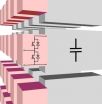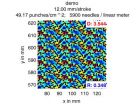(Press-News.org) UPTON, NY In theory, plants could be the ultimate green factories, engineered to pump out the kinds of raw materials we now obtain from petroleum-based chemicals. But in reality, getting plants to accumulate high levels of desired products has been an elusive goal. Now, in a first step toward achieving industrial-scale green production, scientists from the U.S. Department of Energys (DOE) Brookhaven National Laboratory and collaborators at Dow AgroSciences report engineering a plant that produces industrially relevant levels of compounds that could potentially be used to make plastics. The research is reported online in Plant Physiology, and will appear in print in the December issue.
Weve engineered a new metabolic pathway in plants for producing a kind of fatty acid that could be used as a source of precursors to chemical building blocks for making plastics such as polyethylene, said Brookhaven biochemist John Shanklin, who led the research. The raw materials for most precursors currently come from petroleum or coal-derived synthetic gas. Our new way of providing a feedstock sourced from fatty acids in plant seeds would be renewable and sustainable indefinitely. Additional technology to efficiently convert the plant fatty acids into chemical building blocks is needed, but our research shows that high levels of the appropriate feedstock can be made in plants.
The method builds on Shanklins longstanding interest in fatty acids the building blocks for plant oils and the enzymes that control their production (see related links below). Discovery of the genes that code for the enzymes responsible for so called unusual plant oil production encouraged many researchers to explore ways of expressing these genes and producing certain desired oils in various plants.
There are plants that naturally produce the desired fatty acids, called omega-7 fatty acids, in their seeds for example, cats claw vine and milkweed but their yields and growth characteristics are not suitable for commercial production, Shanklin said. Initial attempts to express the relevant genes in more suitable plant species resulted in much lower levels of the desired oils than are produced in plants from which the genes were isolated. This suggests that other metabolic modifications might be necessary to increase the accumulation of the desired plant seed oils, Shanklin said.
To overcome the problem of poor accumulation, we performed a series of systematic metabolic engineering experiments to optimize the accumulation of omega-7 fatty acids in transgenic plants, Shanklin said. For these proof-of-principle experiments, the scientists worked with Arabidopsis, a common laboratory plant.
Enzymes that make the unusual fatty acids are variants of enzymes called desaturases, which remove specific hydrogen atoms from fatty acid chains to form carbon-carbon double bonds, thus desaturating the fatty acid. First the researchers identified naturally occurring variant desaturases with desired specificities, but they worked poorly when introduced into Arabidopsis. They next engineered a laboratory-derived variant of a natural plant enzyme that worked faster and with greater specificity than the natural enzymes, which increased the accumulation of the desired fatty acid from less than 2 percent to around 14 percent.
Though an improvement, that level was still insufficient for industrial-scale production. The scientists then assessed a number of additional modifications to the plants metabolic pathways. For example, they down-regulated genes that compete for the introduced enzymes fatty acid substrate. They also introduced desaturases capable of intercepting substrate that had escaped the first desaturase enzyme as it progressed through the oil-accumulation pathway. In many of these experiments they observed more of the desired product accumulating. Having tested various traits individually, the scientists then combined the most promising traits into a single new plant.
The result was an accumulation of the desired omega-7 fatty acid at levels of about 71 percent in the best-engineered line of Arabidopsis. This was much higher than the omega-7 fatty acid levels in milkweed, and equivalent to those seen in cats claw vine. Growth and development of the engineered Arabidopsis plants was unaffected by the genetic modifications and accumulation of omega-7 fatty acid.
This proof-of-principle experiment is a successful demonstration of a general strategy for metabolically engineering the sustainable production of omega-7 fatty acids as an industrial feedstock source from plants, Shanklin said.
This general approach identifying and expressing natural or synthetic enzymes, quantifying incremental improvements resulting from additional genetic/metabolic modifications, and stacking of traits may also be fruitful for improving production of a wide range of other unusual fatty acids in plant seeds.
INFORMATION:
This research was funded by the DOE Office Science, and by The Dow Chemical Company and Dow AgroSciences.
Scientific paper: Metabolic engineering of seeds can achieve levels of omega-7 fatty acids comparable to the highest levels found in natural plant sources: http://www.plantphysiol.org/cgi/reprint/pp.110.165340v2
Dow Contact:
Robyn Heine
Dow AgroSciences
317 337-4807
Related Links
Enzyme Detectives Uncover New Reactions, Products: http://www.bnl.gov/bnlweb/pubaf/pr/PR_display.asp?prID=810
New Success in Engineering Plant Oils: http://www.bnl.gov/bnlweb/pubaf/pr/PR_display.asp?prID=07-24
Study Finds Plant Enzyme Function Changes with Location in Cell: http://www.bnl.gov/bnlweb/pubaf/pr/PR_display.asp?prID=04-72
Scientists Push Enzyme Evolution Into High Gear: http://www.bnl.gov/bnlweb/pubaf/pr/2001/bnlpr061301.htm
Brookhaven Lab Joins an Alliance to Perform Research That May Lead to Improved Oilseed Crops: http://www.bnl.gov/bnlweb/pubaf/pr/2000/bnlpr030900.html
One of ten national laboratories overseen and primarily funded by the Office of Science of the U.S. Department of Energy (DOE), Brookhaven National Laboratory conducts research in the physical, biomedical, and environmental sciences, as well as in energy technologies and national security. Brookhaven Lab also builds and operates major scientific facilities available to university, industry and government researchers. Brookhaven is operated and managed for DOE's Office of Science by Brookhaven Science Associates, a limited-liability company founded by the Research Foundation of State University of New York on behalf of Stony Brook University, the largest academic user of Laboratory facilities, and Battelle, a nonprofit, applied science and technology organization.
Visit Brookhaven Lab's electronic newsroom for links, news archives, graphics, and more: http://www.bnl.gov/newsroom
END
The messenger interleukin-27 plays an important role when the human body blocks inflammations. This was discovered by an international research team, of which the Kiel Professors Joachim Grötzinger and Stefan Rose-John, as well as the doctoral candidate, Björn Spudy, are a part of. The research findings of the scientists from Kiel, the US and Great Britain were published yesterday, Sunday (7 November 2010), in the online advance edition of Nature Immunology.
The human immune system reacts to bodily injuries and infections with inflammation. This is important for the healing ...
Cars and trucks race down the highway, turn off into town, wait at traffic lights and move slowly through side streets. Electricity flows in a similar way – from the power plant via high voltage lines to transformer substations. The flow is controlled as if by traffic lights. Cables then take the electricity into the city centre. Numerous switching points reduce the voltage, so that equipment can tap into the electricity at low voltage. Thanks to this highly complex infrastructure, the electricity customer can use all kinds of electrical devices just by switching them on. ...
BOSTON, November 8, 2010 – California pistachios took center stage at this year's American Dietetic Association's annual Food & Nutrition Conference & Expo (FNCE), the industry's premier conference where thousands of registered dietitians gather to learn about innovative nutrition research and emerging health trends.
Pistachios led with a strong presence with new research on the importance of mindful eating and, for the first time ever, participating in a session on emerging green food issues and solutions designed to sustain the environment along with good health.
The ...
Learning a hobby or other complex task in childhood with assistance from a trusted adult may help guard against the emergence of a personality disorder (PD) later on in life, reports a study in the current issue of the journal, Development and Psychopathology.
Spending time with a child by reading with them, helping with homework or teaching them organizational skills helps to foster better psychological health in adulthood.
"The strong interpersonal connectedness and social skills that children learn from having active, healthy engagements with adults fosters positive ...
What do diapers, wiping cloths, wall paneling, sticking plasters and Ultrasuede covers for upholstered furniture have in common? All these products are made of nonwovens. There is hardly any other fabric that is as versatile. Last summer the operators of the Zugspitze railroad even used sheets of nonwovens to prevent the snow melting away on Germany's highest mountain. The quality of this textile, however, varies considerably. It is generally true to say that the firmer, the smoother and the freer of marks the nonwoven is, the higher the quality. In the search for the perfect ...
A team of Italian scientists has fired a laser beam into a hunk of glass to create what they believe is an optical analogue of the Hawking radiation that many physicists expect is emitted by black holes. Although the laser experiment superficially bears little resemblance to ultra-dense black holes, the mathematical theories used to describe both are similar enough that confirmation of laser-induced Hawking radiation would bolster confidence that black holes also emit Hawking radiation.
When Stephen Hawking first predicted the radiation bearing his name in 1974, he hypothesized ...
ANN ARBOR, Mich. - Door-to-balloon time has dropped dramatically as hospitals rush heart attack patients into treatment, but a five-year study released Monday shows quicker hospital care has not saved more lives.
Heart attacks are a medical emergency and hospitals race against the clock to open the clogged artery causing the attack in 90 minutes or less.
Door-to-balloon time is the amount of time between a heart attack patient's arrival at the hospital to the time he or she receives an intervention, such as a balloon angioplasty, to open the artery.
The study published ...
A new study shows how an amphibious fish stays alive for up to two months on land. It's all in the skin.
Mangrove killifish are small fish—only about an inch or two long—that live in temporary pools in the coastal mangrove forests of Central and South America and Florida. During dry seasons when their pools disappear, the fish hole up in leaf litter or hollow logs. As long as they stay moist, they can survive for extended periods out of water by breathing air through their skin. But oxygen isn't the only thing a fish out of water needs to worry about, according to Professor ...
Chapel Hill - A new discovery by UNC scientists describes how cells infected by the Epstein-Barr virus (EBV) produce small vesicles or sacs called exosomes, changing their cellular "cargo" of proteins and RNA. This altered exosome enters cells and can change the growth of recipient cells from benign to cancer-producing.
In this way, virus-infected cells can have wide-ranging effects and potentially manipulate other cells throughout the body. The findings are reported in the November 8, 2010 early online edition of the Proceedings of the National Academy of Sciences.
Nancy ...
University of Toronto scientists have found that chemicals used to line junk food wrappers and microwave popcorn bags are migrating into food and being ingested by people where they are contributing to chemical contamination observed in blood.
Perfluorinated carboxylic acids or PFCAs are the breakdown products of chemicals used to make non-stick and water- and stain-repellant products ranging from kitchen pans to clothing to food packaging. PFCAs, the best known of which is perfluorooctanoic acid (PFOA), are found in humans all around the world.
"We suspected that ...




